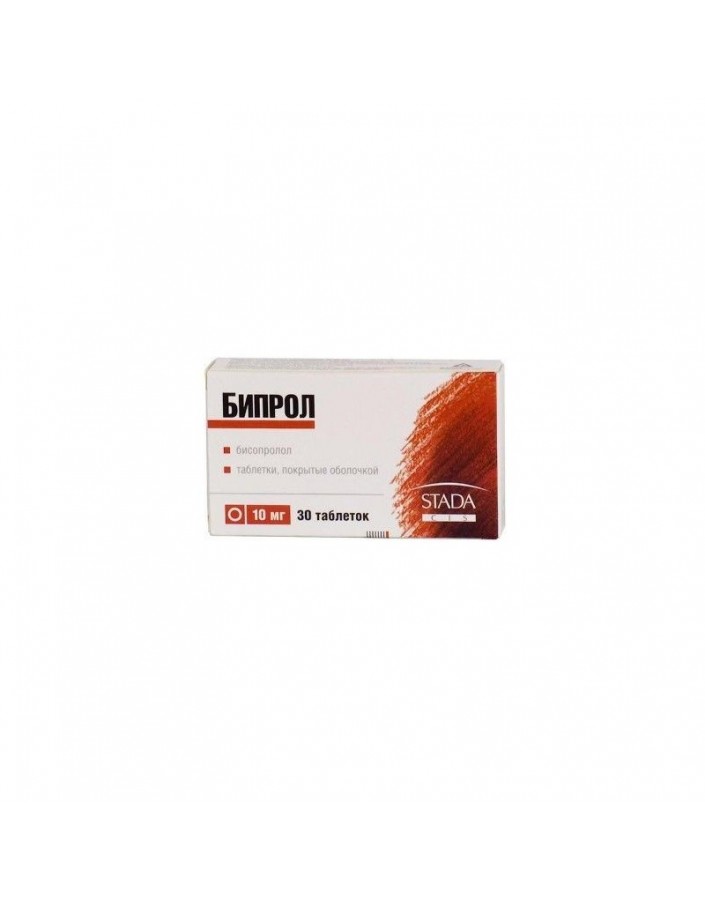




Security policy (edit with Customer reassurance module)

Delivery policy (edit with Customer reassurance module)

Return policy (edit with Customer reassurance module)
30 pieces
Biprol has a hypotensive, antiarrhythmic, antianginal effect.
Arterial hypertension;
CHD: prevention of angina attacks.
Biprol use during pregnancy and lactation is possible if the benefit to the mother exceeds the risk of side effects in the fetus and child.
The drug should be taken orally, in the morning on an empty stomach, without chewing, 5 mg once. If necessary, increase the dose of Biprol to 10 mg once a day. The maximum daily dose is 20 mg / day.
Monitoring patients taking Biprol should include measuring heart rate and blood pressure, conducting an ECG, and measuring blood glucose in diabetic patients. In elderly patients, it is recommended to monitor renal function.
The use of allergens used for immunotherapy or extracts of allergens for skin tests during Biprol therapy increases the risk of severe systemic allergic reactions or anaphylaxis. With the simultaneous use of Bisoprolol Iodine radiopaque drugs for intravenous administration increases the risk of Anaphylactic reactions. With simultaneous appointment with bisoprolol phenytoin for intravenous administration, drugs for general inhalation anesthesia (hydrocarbon derivatives) increase the severity of the cardiodepressant effect and the likelihood of a decrease in blood pressure. With simultaneous use of bisoprolol changes the effectiveness of insulin and oral hypoglycemic drugs, masks the symptoms of developing hypoglycemia (tachycardia, increased blood pressure).With simultaneous use of bisoprolol reduces the clearance of Lidocaine and xanthines (except difillin) and increases their concentration in plasma, especially in patients with initially increased clearance of theophylline under the influence of smoking. The hypotensive effect of bisoprolol is reduced by NSAIDs (Na + delay and blockade of prostaglandin synthesis by the kidneys), GCS and estrogens (Na + ion retention). With simultaneous use of cardiac glycosides, methyldopa, reserpine and guanfacine, Calcium channel blockers (verapamil, diltiazem), Amiodarone, and other antiarrhythmic drugs increase the risk of developing or worsening bradycardia, AV blockade, cardiac arrest, and heart failure. With simultaneous use with bisoprolol, Nifedipine can lead to a significant decrease in blood pressure. When used simultaneously with bisoprolol, diuretics, clonidine, sympatholytics, hydralazine and other antihypertensive drugs can lead to an excessive decrease in blood pressure. Bisoprolol prolongs the action of non-depolarizing muscle relaxants and the anticoagulant effect of coumarins. Three - and tetracyclic antidepressants, antipsychotic drugs (neuroleptics), ethanol, sedatives and hypnotic drugs increase the inhibitory effect of bisoprolol on the central nervous system. The simultaneous use of bisoprolol with MAO inhibitors due to a significant increase in the hypotensive effect is not recommended (the interval between taking MAO inhibitors and bisoprolol should be at least 14 days).With simultaneous use with bisoprolol, non-hydrogenated ergot alkaloids, ergotamine increase the risk of developing peripheral circulatory disorders. With simultaneous use of Sulfasalazine increases the concentration of bisoprolol in the plasma. With simultaneous use of rifampicin reduces T 1/2 of bisoprolol.
Symptoms: arrhythmias, ventricular premature beats, severe bradycardia, AV blockade, marked reduction in blood pressure, chronic heart failure, cyanosis of the fingernails and palms of the nails, difficulty breathing, bronchospasm, dizziness, syncope, convulsions.
Treatment: gastric lavage, the appointment of adsorbents. If necessary, carry out symptomatic therapy: with developed AV-blockade in / in the introduction of atropine (1-2 mg), epinephrine or staging a temporary pacemaker; with ventricular extrasystole - lidocaine (I class A drugs are not used). With a decrease in blood pressure, the patient should be in the Trendelenburg position; if there are no signs of pulmonary edema, inject intravenously plasma-substituting solutions; with ineffectiveness - the introduction of epinephrine, dopamine, dobutamine (to maintain chronotropic and inotropic action and eliminate the pronounced decrease in blood pressure). In heart failure, cardiac glycosides, diuretics, glucagon are prescribed; with convulsions - in / in diazepam; with bronchospasm - beta 2 -adrenostimulators inhalation.
In a dry, dark place at a temperature of no higher than 25 ° C.